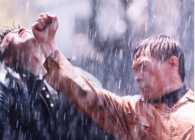The
Sydney Asia Pacific Film Festival
by Eugne Chew
The inaugural SAPFF ran from March30th to April 2nd, screening
9 Asian
features and 12 Asian-Australian short films. Each film
was selected on the basis of critical and box-office success in their country
of origin. This prerequisite of commercial success is an unusual criteria
for foreign film festivals, which generally cater towards a more arthouse
audience.
 
Nang Nak and Nowhere to
Hide
|
The festival was well attended, with over 3000 people squeezing
into
Chinatown's Reading cinemas. Surprisingly, just over
half the attendees were white Australians, according to one festival insider,
perhaps because the various ethnic communities had already seen the films
overseas or on pirated VHS and VCD copies. Regardless, most of the sessions
filled quickly, the Japanese films "Perfect Blue" and "Shark Skin Man and
Peach Hip Girl" being especially popular, along with the gory yet beautiful
Thai ghost-story "Nang Nak", which sold out despite a repeat screening.
Yet it was the Korean films "Nowhere to Hide" and "The
Quiet Family" which stole the show, thrilling audiences with their kinetic
camera work, perversely black humour and genre-defying inventiveness.
The Korean film industry is undergoing a grassroots renaissance, with a
new generation of film-makers producing aggressively confronting films
in response to the mainstream staple of weepy melodramas and soap-operas.
"The Quiet Family" was a farcical comedy about a family
forced to cover up one death after another, in an attempt to save their
mountain-lodge from
bankruptcy, only to find you can't sweep everything under
the carpet before it becomes impossible to stand on. Its conspiratorial
theme bordered on political satire, the final shot suggesting that every
Korean, no matter how silent or apathetic, is complicit in the country's
political crises and suppression of ugly truths.

The Quiet Family
|

Where a Good Man Goes
|
The playfully kinetic chase-film "Nowhere to Hide" opened
the festival with
director Lee Myung-Se and star Park Joong-Hoon flying
in as official guests. Using a variety of comic-book inspired and computer
generated visual-effects, the film distorted temporality and narrative
genre to focus on the beauty of movement. Another festival highlight
was the Hong Kong comedy "Where a Good Man Goes", set in Macau, directed
by the under-profiled Johnnie To and starring Lau Ching-Wan, whose roguish
charm has made him one of Asia's best actors. Pleasantly different from
the usual Hong Kong film, "Where a Good Man Goes" isdriven by good acting
and character development, instead of choreographed combat, celebrity cameos
or sheer scale.
The SAPFF also included two free seminars open to the
public, the first about Asians in the Australian film industry, and the
other about Australia's
role in the Asian film industry. The issues covered included
the lack of Asian
representation in Australian narratives, with the few
roles on offer being
either heavily stereotyped or tokenistic. On the panel
were two
Asian-Australian actors, Linden Goh and Anthony Wong.
Linden argued that bad representation was better than no representation,
whilst Anthony criticised the type-casting of Asian men as asexual, bisexual
or homosexual, an observation that was borne out in the prevalence of homosexual
themes in the Asian-Australian short films.
In all, the SAPFF is a valuable addition to the cultural
scene in Australia,
and goes a long way towards correcting mainstream Australia's
palpable
ignorance of Asian cultures and Asians in Australia.
The festival's organisers
are already back in Asia, attending local film festivals
and scouting out new
talent for next year's program. Keep your eye out for
screening details, this
time next year, as it promises to be bigger and better.
|



